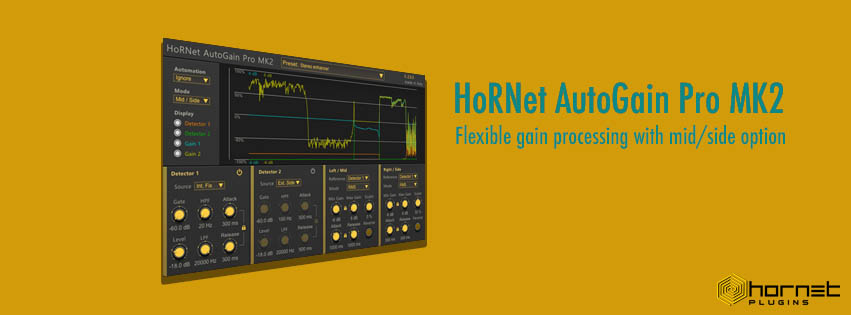|
HoRNet Corrosion 60% off with code CORRO60 for the next |
We are excited to announce the release of HoRNet AutoGain Pro MK2, a powerful and highly flexible volume processor designed for precision control over dynamics, loudness, and stereo image. Building upon the legacy of the original AutoGain Pro, this new version offers a completely re-engineered workflow and expanded capabilities, giving audio professionals a more versatile […]

We are excited to announce the release of HoRNet AutoGain Pro MK2, a powerful and highly flexible volume processor designed for precision control over dynamics, loudness, and stereo image. Building upon the legacy of the original AutoGain Pro, this new version offers a completely re-engineered workflow and expanded capabilities, giving audio professionals a more versatile tool for automated gain control, dynamic shaping, and even advanced stereo processing.
AutoGain Pro MK2 is not just a simple upgrade—it represents a significant evolution in our gain automation technology. While it retains the essence of the original plugin, particularly when used in “classic mode”, it introduces an entirely new level of processing depth and routing flexibility. The most notable enhancement is the addition of dual processing paths, each with its own detector and gain processor, effectively doubling the power compared to the previous version. This makes AutoGain Pro MK2 not only suitable for basic volume riding, but also a serious contender in the realm of compressors, transient shapers, and mid/side processors.
At its core, HoRNet AutoGain Pro MK2 is designed to offer transparent and musical gain automation. The plugin continuously analyzes the level of the incoming audio signal using one or two independent detectors, then applies calculated volume adjustments through one or two independent processors. The new architecture allows each processor to receive input from either of the two detectors, opening the door to creative configurations, parallel gain control, or nuanced dynamic shaping.
One of the most powerful features of AutoGain Pro MK2 is its ability to operate in stereo or mid/side mode. In stereo mode, the plugin processes the left and right channels in a conventional fashion, which is ideal for most mixing and mastering tasks. However, in mid/side mode, the plugin separates the signal into its mono (mid) and stereo (side) components, allowing you to apply independent gain control to each part. This is incredibly useful for controlling the width and balance of a mix, taming excessive stereo spread, or enhancing the clarity of central elements like vocals, kick drums, or bass.
Each detector within the plugin can be configured to respond to one of five available signal sources, including internal audio, external sidechain input, and additional routing options. This allows you to create complex sidechain gain control schemes, such as ducking the music under a vocal, automating the volume of a synth based on a kick drum, or applying dynamic enhancements based on external rhythmic patterns.
Each gain processor can be independently routed to receive its control signal from either detector one or detector two, giving you the freedom to build advanced gain processing chains. For example, you can have detector one monitoring the mid signal while processor two adjusts the side signal in response, or use an external signal to influence the dynamic response of one channel while the other remains unaffected. These routing options are not just technical capabilities—they’re creative tools that enable entirely new approaches to mixing and dynamic control.
The “classic” mode included in AutoGain Pro MK2 replicates the behavior of the original AutoGain Pro, preserving the simplicity and transparency that made it a favorite among engineers for smooth, unobtrusive volume automation. But when you step beyond classic mode into full dual-path processing, the plugin reveals its modern identity as a dynamic shaping powerhouse.
Visually, AutoGain Pro MK2 features a clean, intuitive interface that makes setup and control straightforward. The real-time gain meter allows you to see exactly how much gain is being applied at any moment, while visual indicators for both detectors help you monitor their response curves and input levels. This makes it easy to dial in precise settings and see the results immediately—perfect for those working under tight deadlines or in fast-paced mixing sessions.
In terms of creative use, AutoGain Pro MK2 can serve multiple roles in your production chain. It can function as an automatic leveler, smoothing out volume inconsistencies across vocal tracks or instruments. It can also act as a compressor alternative, providing a more transparent and less colored form of dynamic control. When used creatively, it can emulate certain behaviors of a transient shaper, accentuating or softening attacks without introducing the artifacts often found in more aggressive dynamics processors.
The plugin’s low CPU usage and support for all major plugin formats (including VST2.4, VST3, Audio Units, and AAX) make it compatible with virtually every major DAW on macOS (10.9 and later) and Windows (7 and later). It operates as a 64-bit plugin, ensuring optimal performance and full integration with modern production environments.
HoRNet AutoGain Pro MK2 is available now for the price of €26.99, making it one of the most affordable yet feature-rich volume processors on the market. For users who already own the original AutoGain Pro, we’re offering a special upgrade price of just €3.99. This allows loyal users to take advantage of the new features and improved workflow without breaking the bank.
Whether you’re working on a vocal-heavy pop track, mastering an orchestral score, crafting tight EDM grooves, or shaping the dynamics of cinematic sound design, HoRNet AutoGain Pro MK2 gives you the precision and power to get the results you need—faster, cleaner, and more musically.
You can download AutoGain Pro MK2 from your user area on the HoRNet website or through our HoRNet DoIn installer. As always, this update is part of our mission to provide professional-grade audio tools at an accessible price point, with the flexibility and quality that modern producers demand.